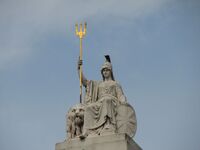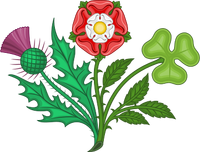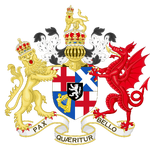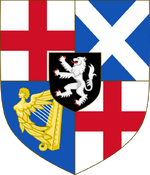The main national symbols of the Commonwealth of England, Scotland and Ireland are the Union Flag and the Arms of the Commonwealth.
National Flags
The national flag and official variants are:
Arms of the Commonwealth
Flags of Home Countries
Home Country |
Flag | Date | Use and status |
|---|---|---|---|
| England | 
|
From c. 1245 | De facto Flag of England (also known as the St George's Cross) |
| Scotland | 
|
Since at least 1513 | Flag of Scotland, also known as the Saint Andrew's Cross or The Saltire |
| Wales | 
|
Widely adopted in the
mid 17th century to represent Wales. |
The flag of Saint David, a yellow cross on a black field. |
| Ireland | 
|
1542 on | A silver stringed gold harp on a blue field. |
| Isle of Man | 
|
1663 on | |
| Channel Islands | 
|
1665 on |
Ensigns and military flags
Flags and arms of the Dominions and others
Anthem
Rule, Britannia! is a British patriotic song that later became the official anthem of the Commonwealth.
Unofficial symbols and motifs

Statue of Britannia.
Britannia is also the name given to the female personification of the island and the Commonwealth of England, Scotland and Ireland. The personification of the martial Britannia is used as an emblem of British maritime power and unity, most notably in "Rule, Britannia!". Britannia became an increasingly important symbol and a strong rallying point among Britons during the European Wars of the 18th century. Its from this period that the personification of Britannia came to represent British liberties and democracy.
The first statue of Britannia was inaugurated as part of the celebrations of the 75th Year of the Commonwealth (1724).

The official British Cockade.
The British Cockade worn in military uniforms from the 18th century onward became fashionable and widely used among the civilian population on the eve of the 100th Year of the Commonwealth (1749). The cockade was later used informally as a citizens' symbol of pledge of alliance, and also has sign of British nationalism and pride.
The Floral Badges of Britannia (or the Commonwealth) consist of the heraldic plant badges of England (Tudor Rose), Scotland (Thistle) and Ireland (Shamrock). The plant badges are grown from the same stem, representing the united home countries.
The original design and idea were taken from the former royal badges. The floral badges, all three together or each one apart, are used as alternative civic or official badges or decorative motif.

The thistle, Tudor rose and shamrock of the floral badge.
| |||||||||||||||||||||||















